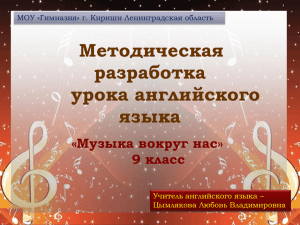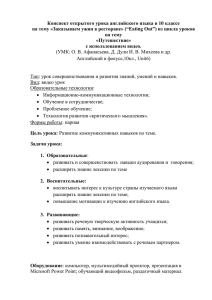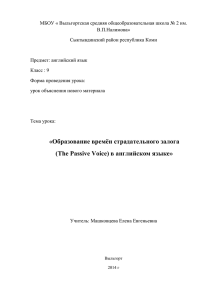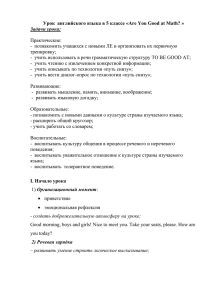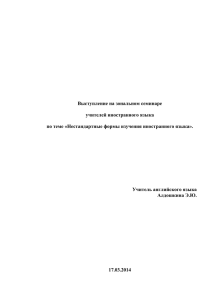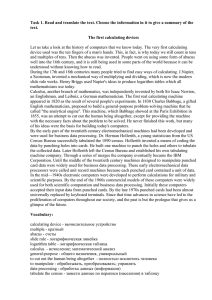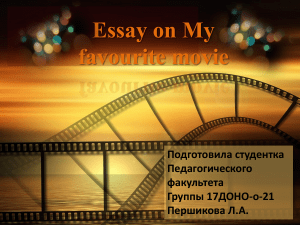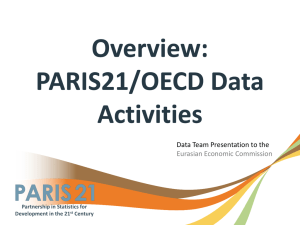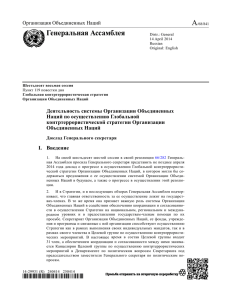УРОК ЧТЕНИЯ ПО УМК В. П. КУЗОВЛЕВА «АНГЛИЙСКИЙ ЯЗЫК
реклама
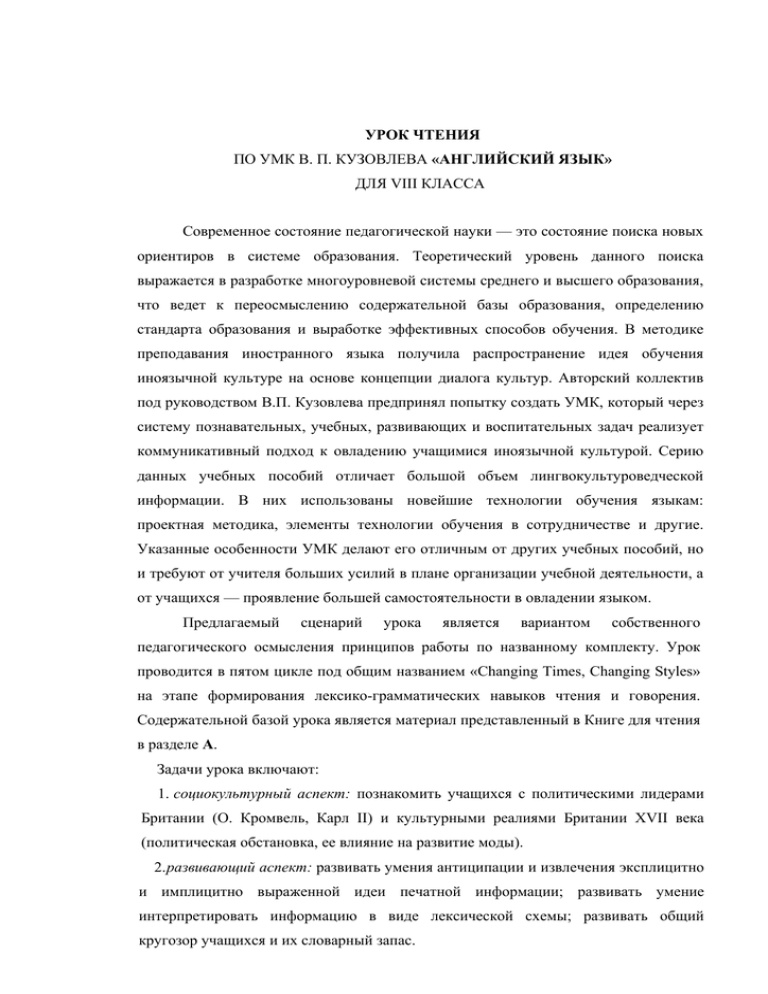
УРОК ЧТЕНИЯ ПО УМК В. П. КУЗОВЛЕВА «АНГЛИЙСКИЙ ЯЗЫК» ДЛЯ VIII КЛАССА Современное состояние педагогической науки — это состояние поиска новых ориентиров в системе образования. Теоретический уровень данного поиска выражается в разработке многоуровневой системы среднего и высшего образования, что ведет к переосмыслению содержательной базы образования, определению стандарта образования и выработке эффективных способов обучения. В методике преподавания иностранного языка получила распространение идея обучения иноязычной культуре на основе концепции диалога культур. Авторский коллектив под руководством В.П. Кузовлева предпринял попытку создать УМК, который через систему познавательных, учебных, развивающих и воспитательных задач реализует коммуникативный подход к овладению учащимися иноязычной культурой. Серию данных учебных пособий отличает большой объем лингвокультуроведческой информации. В них использованы новейшие технологии обучения языкам: проектная методика, элементы технологии обучения в сотрудничестве и другие. Указанные особенности УМК делают его отличным от других учебных пособий, но и требуют от учителя больших усилий в плане организации учебной деятельности, а от учащихся — проявление большей самостоятельности в овладении языком. Предлагаемый сценарий урока является вариантом собственного педагогического осмысления принципов работы по названному комплекту. Урок проводится в пятом цикле под общим названием «Changing Times, Changing Styles» на этапе формирования лексико-грамматических навыков чтения и говорения. Содержательной базой урока является материал представленный в Книге для чтения в разделе А. Задачи урока включают: 1. социокультурный аспект: познакомить учащихся с политическими лидерами Британии (О. Кромвель, Карл II) и культурными реалиями Британии XVII века (политическая обстановка, ее влияние на развитие моды). 2. развивающий аспект: развивать умения антиципации и извлечения эксплицитно и имплицитно выраженной идеи печатной информации; развивать умение интерпретировать информацию в виде лексической схемы; развивать общий кругозор учащихся и их словарный запас. 3. воспитательный аспект: стимулировать учащихся к самостоятельной работе; развивать положительные личностные качества (ответственность, доброжелательность, чувство взаимопомощи); развивать умение работать в коллективе и принимать совместное решение. 4. учебный аспект: развивать умение читать с извлечением основной и полной информации из прочитанного текста. Сопутствующая задача — развивать умение говорить в монологической форме на основе печатной информации и лексической схемы. Оформление урока: плакат с темой урока и ключевыми подземами; репродукции политических лидеров Британии (О. Кромвель, Карл II); карточки с индивидуальным заданием для ознакомительного чтения; вопросы для работы в экспертной группе; таблицы для заполнения лексической схемы; набор слов для введения в сюжет урока; карточки с именами политических лидеров. Ход урока. I. Презентация темы и задач урока. До начала урока ученический коллектив должен быть рассажен по рабочим группам. С этой целью на партах расставлены имена. В группу целесообразно включать трех учащихся разного уровня обученности. В дальнейшем каждому члену группы будет дана индивидуальная карточка для работы с текстом, в которой сложность задания будет зависеть от уровня компетенции ученика. Good morning, dear friends. I'm glad to see you in our new Museum of Fashion. We are here to listen to some stories about the past, to read some historical pages from British history and to discuss several questions. All these questions and information are connected with the following words and combinations of words. Look at them. They are Colours & Tints. Stone Age. Middle Ages, Accessories, Design, and Roman Empire. Bсe указанные слова должны быть расставлены на магнитной доске в произвольном порядке. Набор тех же самых слов должен быть на столах у каждой группы. Divide them into 2 columns. Explain your choices. You've got 30 seconds to do this task. Дети распределяют слова по группам. Учитель проверяет группы, выбирает ту из них, ответы которой не содержат ошибок, и просит группу озвучить результаты выбора. По мере представления ответов учитель расставляет слова на магнитной доске в логическом порядке на две группы. Well, you could guess the key-words of today's work are "Times" and "Styles". Одновременно с этим на магнитной доске учитель расставляет слова-ключи над колонками слов. (Ключи: Styles: Colours & Tints, Accessories, Design. Times: Stone Age, Middle Ages, Roman Empire.) So the theme is "Fashion" and the questions to read and discuss are: 1. What can influence fashion? 2. Who can affect fashion? 3. What were the fashions of the past? Учитель указывает на плакат с названием темы урока и основными вопросами занятия. Затем необходимо обратить внимание учащихся на доску, где записаны дополнительные слова к обсуждению вопросов и пониманию текстов. These words could be helpful to us. (Читаю их). Read them after me, please. Words: influence [inflυəns] smth affect [əfekt] smth влиять have an effect on smth reign [rein] - править Try to use them in your answers. II. Развитие умения антиципации. 1. Подготовительный этап. a) By the way, what do you think can influence fashion? (Предположения детей.) b) Can the political situation have an effect on fashion? Well, let's see if you're right. Two political leaders will help us. They represent British history in the period from 1649 to 1685. Their names are Oliver Cromwell, or the Lord Protector, and King Charles II. Показываю портреты этих лидеров. What do you know about them? c) What were the fashions during the reign of the Lord Protector? Were the colours bright or dark? d) There are some words to help us describe his fashion. Open your Reader, please. Ex. 1, p. 63. Look through the words: fancy, somber, sober, drab, plush, elaborate, cuff, tuck, dye stuff, garments, array, apparel. Answer the questions, please. • Which of them could mean colours & tints? (Keys: sober, somber, drab.) • Which of these adjectives could be used to describe something positive? (Keys: elaborate, fancy.) • Which ones are used to speak about something pessimistic? (Keys: sober, somber.) • Which words represent items of clothing? (Keys: cuff, tuck.) • What are the synonyms for the word "dress"? (Keys: apparel, garments, array.) 2. Выражение предположения. Use these words to describe the clothes of Oliver Cromwell and Charles II. III. Чтение с извлечением основной информации. 1. Организация работы. Take your pencils now. Read the text about the leaders. Mark the information that we've guessed with this sign (+), and mark the wrong facts with the help of a "–". You have 2 minutes to read the text. The text The differences in the politics of Oliver Cromwell and King Charles II help explain the style of dress of the two men in these two portraits. The picture shows Oliver Cromwell who ruled England as Lord Protector. Cromwell believed in telling the truth and would not let painters flatter him. He wanted to be painted "warts and all". Oliver Cromwell was a Puritan. His policy was severe, he ruled as a dictator. Under his rule, English men and women had to obey the strict and solemn rule of the Puritans as "children of God." The Puritans outlawed horse racing, gambling, public dancing, newspapers, and wearing fancy clothes. The Puritans also closed the theatres, since to them plays were "spectacles of pleasure." During his reign, fashions were very somber and sober arrays. Tucks and dye-stuffs were considered sinful. During Cromwell's Protectorship, Charles II lived in Paris. In 1660, he became the King of England. He preferred the pleasure of being King to the hard work of ruling the country. Charles II, who "never said a foolish thing, nor ever did a wise one" was a welcome change from Cromwellian rule. His reign was carefree and relaxed, as his portrait suggests. In sharp contrast to the drab Puritan leader, Charles II enjoyed elegant garments. His court copied the plush clothing, rich jewellery, and elaborate wigs of Paris. They also wore lace cuffs. 2. Чтение текста. Контроль прочитанного + дополнительные вопросы. Read out the true facts that you've guessed. Are there any mistakes? Then, can you answer some more questions? • What's the text about? • How many parts are there in the text? What's the main idea of each part? IV. Чтение с детальным пониманием информации. 1. Индивидуальная работа с текстом. Why not come back to our text? Read it more carefully, and do your personal tasks. There are special cards on your tables. Your names are on these cards. Take them and do them. You've got 3-4 minutes to do them. Виды карточек. Card 1 1. What does the expression "warts and all" mean? a) Sink or swim; b) Only the bad points of a character; c) Only the best parts of a person; d) To mention the good and bad parts of a character. 2. Whom does this expression belong to? 3. How does it characterize the person? Card 2 1. Use the text to choose words to characterize Oliver Cromwell. 2. How do they describe that person? Card 3 1. Use the text to find the words and combinations of words that mean: a) not to tell a lie; b) to mention good and bad parts of a character; c) to describe somebody better than he is; d) to do what one is told to do; e) a person whose reign is based on strict rules and an army. 2. Which of the two leaders can be described with the words in ex. 1? 3. How does it characterize that person? Card 4 1. What does the word "Puritan" mean? a) A person who is supposed to wear clean clothes; b) A person who is said to be strict in morals and religion; c) A person who is reported to be rather superstitious; d) A person who rules the country as a dictator. 2. Whom does this word ("Puritan") describe? 3. Who can be called a Puritan? How does it characterize a person? Card 5 1. What activities did a Puritan consider to be sinful? 2. How do these ideas characterize the Puritans? 3. What person (leader) is described with the help of these activities? Why do you think so? Card 6 1. Use the text to find the words that mean: a) to ban, make somebody not do some activities; b) very bad for a religious person; с) а place for sinful watching; d) an adjective that describes apparel as dark and dull. It is reported to be the main characteristic of the Puritans (their fashion). 2. How do the words of ex. 1 characterize the Puritans? Card 7 1. What does the expression "never said a foolish thing, nor did a wise one" mean? a) to be as clever as a fox; b) to be a rather silly person; c) to be an ordinary (lazy) person; d) to be deaf and dumb (глухонемой). 2. Who is characterized with the help of that quotation? 3. What do you think of such a person? Card 8 1. Find all the words that could characterize Charles II. 2. How would you describe him? Why? Card 9 1. Use the text to find all the words that have the following meaning: a) something you like very much and you don't have to work hard at; b) an adjective that characterizes your state (состояние) when you have a holiday; c) it means (describes) a stupid idea or action; d) it means the state when you needn't think of anything serious or important. 2.Whom do the words in ex. 1 describe? 3.How do they characterize this person? Card 10 1. Use the text to find synonyms for these words in the text. a) to have an example; b) colouring matter; c) dark; d) smart, refined, perfect. 2. What do these words describe? Card 11 1. Use the text to find the words that can characterize the style of dress of Charles II. 2. What can you tell us about the character of the King using these words? Card 12 1. Guess the words with the help of the following definitions: a) It's said to be the material that the clothes are made of. b) It's marked as an expensive item or an accessory worn round the neck, c) The sleeves of this garment are not buttoned but tied with a special rope round the hands, d) It's said to be worn on the head, but it's not a hat or a cap. 2. Whose apparel is described here? 3. How does it characterize this leader? Карточки 2, 5, 8, 11 являются наиболее легкими, так как опираются полностью на текст. 2. Работа в экспертной группе. После того как индивидуальная работа с текстом завершена, начинается этап коллективной работы с текстом на уровне осознания эксплицитно и имплицитно выраженной авторской идеи. Every card has its own symbol. If you collect all the parts of the symbols, you'll have a picture. Go around the class and match the parts. На оборотной стороне индивидуальных карточек в центре расположен фрагмент рисунка, соединив карточки, дети получают целое изображение. В результате такого поиска складываются новые рабочие (экспертные) группы. Well, you've found partners to share your ideas with. Now you are experts. You've got some more tasks to do. Take your list. Answer the questions and be ready to explain some facts to the others. You have 3 minutes to complete the task. Виды рисунков. Сложившийся рисунок является ключом к серии вопросов для коллективного обсуждения внутри каждой экспертной группы. В состав вопросов входят задания на информирование о результатах личного прочтения текста и на обобщение сути прочитанного. Данная серия вопросов обозначена нами понятием «лист». Лист № 1 Лист № 2 Лист № 3 Лист № 4 Список вопросов для группового обсуждения. List № 1 1. Look through all the answers you've got in your group. 2. Discuss the following question: "What kind of person was Oliver Cromwell?" 3. Be ready to answer it. List № 2 1. Look through all the answers you've got in your group. 2. Discuss the following question: "What kind of religion was Puritanism? How did it influence the fashion?" 3. Be ready to answer it. List № 3 1.Look through all the answers you've got in your group. 2.Discuss the following question: "What kind of person was King Charles II?" 3.Be ready to answer it. List № 4 1.Look through all the answers you've got in your group. 2.Do the following task together: "Compare the garments of two leaders (their differences and preferences)." 3.Be ready to answer it. 3. Работа в «домашней» группе. Go back to your home group. Exchange your ideas with your partners. Be ready to answer the questions: • What kind of person was Oliver Cromwell? • What kind of person was King Charles II? • How did they influence the way people dressed? 4. Обобщение информации на основе «Словесной паутинки» (лексической схемы). If you are ready, complete the Word Web. Choose a card with the name of the leader you are going to speak about. Дети тянут карточку с названием (именем) правителя. О нем они должны заполнить схему и рассказать. Таким образом две группы готовят выступление о Кромвеле и две других - о Карле II. Fill in the Word Web. Keep in mind the three questions we have to answer today. The spaces from 1 to 5 are for the reasons (ways) the person affected the fashion during his reign. Предлагаемая лексическая схема: V. Подведение итогов работы на уроке. It's time to make our conclusion. Use your Word Web and the questions you've already discussed to speak about Charles II and Oliver Cromwell. When one group presents a story, the others' task is to listen attentively and try to add some more information. Please, don't forget to suggest your own point of view on the subject of our work. Share your ideas while answering who and what can influence fashion. After that, we will match the Word Webs you've got with those I have. После того, как все вопросы прошли обсуждение в группе, а лексическая схема составлена, задача каждой группы - представить свое словесное резюмеописание политического деятеля и течений в моде в период его правления. Выступление строится с опорой на заполненную схему и главные вопросы урока. Задача других команд - прослушать резюме и дополнить (уточнить) информацию. You did great! I should say that you are perfect experts. If we compare our Word Webs, you'll find that they don't differ much. VI. Домашнее задание. You've done your best today. I believe you will do your homework very well. It's ex. 2, p. 64-65. O.B. Игумнова, старший преподаватель КГПА, г. Новокузнецк
